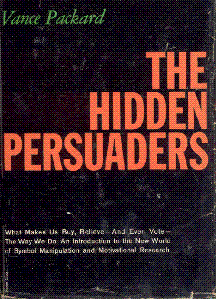Vance Packard
| Vance Packard | |
|---|---|
| Born |
May 22, 1914 Granville Summit, Pennsylvania |
| Died |
December 12, 1996 (aged 82) Martha's Vineyard, Massachusetts |
| Occupation | American journalist, social critic, and author |
| Spouse(s) | Virginia Matthews |
| Parent(s) |
Philip J. Packard Mabel Case Packard |
Vance Packard (May 22, 1914 – December 12, 1996) was an American journalist, social critic, and author.
Life and career
He was born in Granville Summit, Pennsylvania, to Philip J. Packard and Mabel Case Packard. Between 1920-32, he attended local public schools in State College, Pennsylvania, where his father managed a dairy farm owned by the Pennsylvania State College (later Penn State University). In 1932, he entered the college as a student majoring in English. He graduated in 1936, and worked briefly for the local newspaper, the Centre Daily Times. He earned his Master's degree at the Columbia University Graduate School of Journalism in 1937. He joined the Boston Daily Record that year as a staff reporter; a year later, he married Virginia Matthews.
About 1940, he became a reporter for the Associated Press, and in 1942, joined the staff of The American Magazine as a section editor, later becoming a staff writer. That periodical closed in July, 1956, and Packard became a writer at Collier's, then, after its closing by the end of the year, devoted his full attention to developing book-length projects of his own. Halfway into the next year,[1] his The Hidden Persuaders was published to national attention, launching him into a career as a full-time social critic, lecturing and developing further books.
In 1961 he was named a Distinguished Alumnus by Penn State.
He died in 1996 at the Martha's Vineyard Hospital.
The Hidden Persuaders

In The Hidden Persuaders, first published in 1957, Packard explores the use of consumer motivational research and other psychological techniques, including depth psychology and subliminal tactics, by advertisers to manipulate expectations and induce desire for products, particularly in the American postwar era. He identified eight "compelling needs" that advertisers promise products will fulfill. According to Packard these needs are so strong that people are compelled to buy products to satisfy them. The book also explores the manipulative techniques of promoting politicians to the electorate. The book questions the morality of using these techniques.[2]
Publications
- 1946 How to Pick a Mate - a guide co-authored with the head of the Penn State marriage counseling service
- 1950 Animal IQ - a popular paperback on animal intelligence
- 1957 The Hidden Persuaders - on the advertising industry - the first of a popular series of books on sociology topics (ISBN 0-671-53149-2)
- 1959 The Status Seekers - describing American social stratification and behavior
- 1960 The Waste Makers - criticizes planned obsolescence describing the impact of American productivity, especially on the national character
- 1960 Oh, Happy, Happy, Happy - foreword by Vance Packard, with Charles Saxon
- 1962 The Pyramid Climbers - describes the changing impact of American enterprise on managers, the structured lives of corporate executives and the conformity they need to advance in the hierarchy
- 1964 The Naked Society - on the threats to privacy posed by new technologies such as computerized filing, modern surveillance techniques and methods for influencing human behavior
- 1968 The Sexual Wilderness - on the sexual revolution of the 1960s and changes in male-female relationships
- 1972 A Nation of Strangers - about the attrition of communal structure through frequent geographical transfers of corporate executives
- 1977 The People Shapers - on the use of psychological & biological testing and experimentation to manipulate human behavior
- 1983 Our Endangered Children - discusses growing up in a changing world, warning that American preoccupation with money, power, status, and sex, ignored the needs of future generations
- 1989 The Ultra Rich: How Much Is Too Much? - examines the lives of thirty American multimillionaires and their extravagances.
See also
References
- New York Times Dec 13 1996 Vance Packard, 82, Challenger of Consumerism, Dies
- The Salon Dec 17, 1996 The Hidden Persuader
- Horowitz, D. (2009) Vance Packard and American Social Criticism (University of North Carolina Press Enduring Editions) ISBN 0-8078-5735-1
- Petersen, William (1960). "Review of The Status Seekers". American Sociological Review. 25 (1): 124–126. doi:10.2307/2088964. JSTOR 2088964.
- Dash, Samuel (1965). "Review of The Naked Society". Annals of the American Academy of Political and Social Science. 306: 204–205. JSTOR 1035075.
- Schwartz, Alan U. (1965). "Review of The Naked Society". Harvard Law Review. 78 (3): 701–705. doi:10.2307/1339131. JSTOR 1339131.
Footnotes
- ↑ "The Hidden Persuaders - Paperback"
- ↑ Gordon Di Renzo (1958) The American Catholic Sociological Review, Vol. 19, No. 4 (Dec., 1958) (Review)